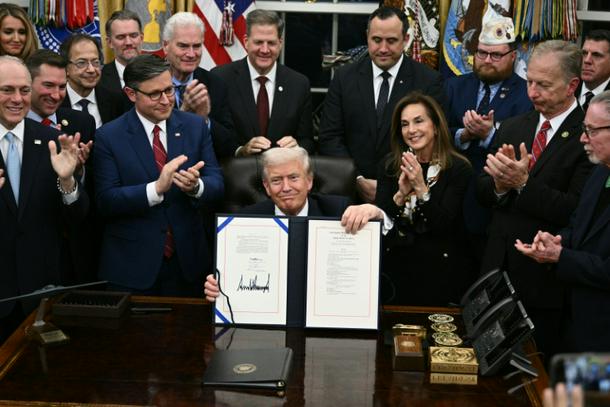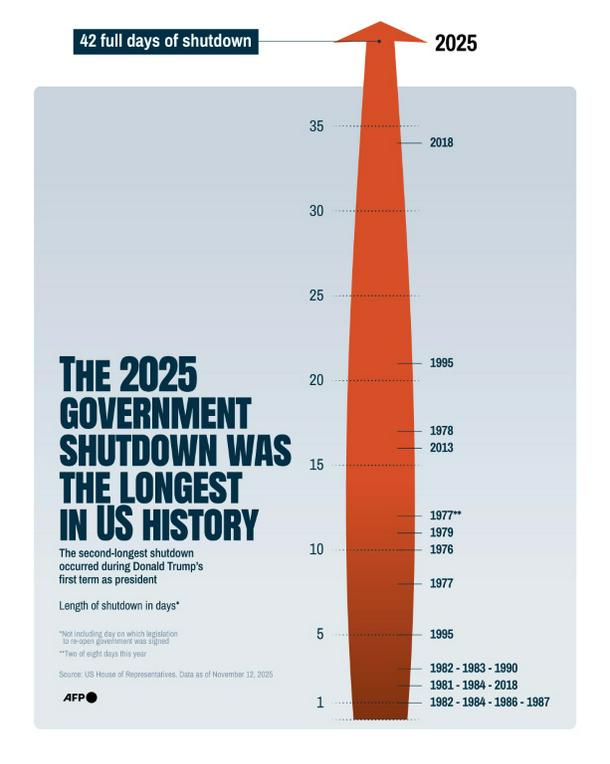
US President Donald Trump (C) shows the signed bill to re-open the federal government in the Oval Office of the White House
Washington (AFP) - The US government was set to take the first tentative steps towards re-opening on Thursday after President Donald Trump signed a bill to end the longest federal shutdown in US history.
The 43-day funding freeze had paralyzed Washington and left hundreds of thousands of workers unpaid while Republicans and Democrats played a high-stakes blame game.
The Republican-led House of Representatives voted on Wednesday, largely along party lines, to approve a Senate-passed package that will reopen federal departments and agencies, as many Democrats fume over what they see as a capitulation by party leaders.
Trump lashed out at Democrats as he put his signature to the bill later in the Oval Office, urging Americans to remember the chaos when voting in hotly contested US midterm elections in a year’s time.
“Today we are sending a clear message that we will never give in to extortion,” said Trump, surrounded by gleeful Republican lawmakers including House Speaker Mike Johnson.
Johnson had earlier pointed the finger at the minority party in a withering floor speech before the vote.
“When we come up to midterms and other things, don’t forget what they’ve done to our country,” Trump said. “So with my signature, the federal government… will now resume normal operations.”
The package funds military construction, veterans’ affairs, the Department of Agriculture, and Congress itself through next fall, and the rest of government through the end of January when lawmakers will again need to reach a funding agreement.
Around 670,000 furloughed civil servants will report back to work, and a similar number who were kept at their posts with no compensation – including more than 60,000 air traffic controllers and airport security staff – will get back pay.
Several federal agencies, including the Justice Department and the Department of Health and Human Services, told their staff to return to the office on Thursday, according to US media.

The 2025 government shutdown was the longest in US history
Travel delays looked set to improve but not disappear with almost 1,000 flights cancelled on Thursday, according to tracking website FlightAware. Authorities said air traffic controller shortages were easing and the transportation secretary on Wednesday released a fresh order for six percent of flights to be frozen – lower than the eight to 10 percent expected under the previous emergency directive.
The deal also restores federal workers fired by Trump during the shutdown, while air travel that has been disrupted across the country will gradually return to normal.
Trump falsely accused Democrats of costing the country $1.5 trillion. While the full financial toll of the shutdown has yet to be determined, the Congressional Budget Office estimates that it has caused $14 billion in lost growth.
- ‘Not backing away’ -
Johnson and his Republicans had almost no room for error as their majority is down to two votes.
Democratic leadership – furious over what they see as their Senate colleagues folding – had urged members to vote no and all but a handful held the line.
Although polling showed the public mostly on Democrats’ side throughout the standoff, Republicans are widely seen as having done better from its conclusion.
For more than five weeks, Democrats held firm on refusing to reopen the government unless Trump agreed to extend pandemic-era tax credits that made health insurance affordable for millions of Americans.
Election victories in multiple states last week gave Democrats further encouragement and a renewed sense of purpose.

The deal passed by the US Senate funds several agencies and progams through the autumn of 2026, and the rest of government through January of that year
But a group of eight Senate moderates broke ranks to cut a deal with Republicans that offers a vote in the upper chamber on health care subsidies – but no floor time in the House and no guarantee of action.
Democrats are now deep in a painful reckoning over how their tough stance crumbled without any notable win.
Democratic leadership is arguing that – while their health care demands went largely unheard – they were able to shine the spotlight on an issue they hope will power them to victory in the 2026 midterm elections.
“Over the last several weeks, we have elevated successfully the issue of the Republican health care crisis, and we’re not backing away from it,” House Minority Leader Hakeem Jeffries told MSNBC.
But his Senate counterpart Chuck Schumer is facing a backlash from the fractious progressive base for failing to keep his members unified, with a handful of House Democrats calling for his head.
Outside Washington, some of the party’s hottest prospects for the 2028 presidential nomination added their own voices to the chorus of opprobrium.
California Governor Gavin Newsom called the agreement “pathetic,” while his Illinois counterpart JB Pritzker said it amounted to an “empty promise.” Former transportation secretary Pete Buttigieg called it a “bad deal.”